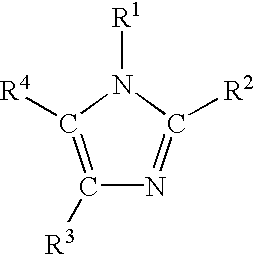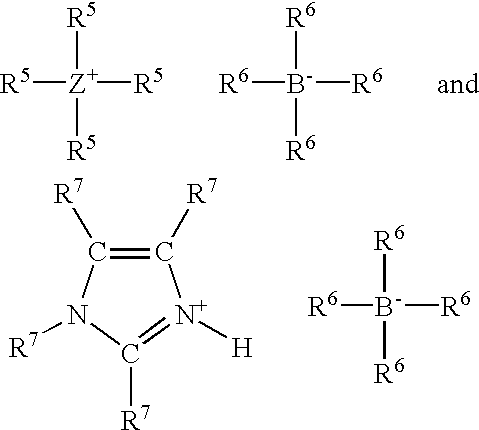Powder coating composition, method for the curing thereof, and articles derived therefrom
a technology of powder coating and composition, which is applied in the direction of coatings, transportation and packaging, synthetic resin layered products, etc., can solve the problems of coatings with reduced physical properties including impact, flexibility, adhesion, and coatings with reduced physical properties, etc., and achieves the effect of smooth matte or low gloss coatings and a smooth surfa
- Summary
- Abstract
- Description
- Claims
- Application Information
AI Technical Summary
Benefits of technology
Problems solved by technology
Method used
Image
Examples
examples 1-8
, COMPARATIVE EXAMPLES 2-8
[0067] The compositions of Examples 1-8 and Comparative Examples 2-8 are given in Table 2. Test results are presented in Table 5. The relative amounts of polyester resin to TGIC varied from one example to another to keep the ratio of acid functionality to epoxy functionality constant as the acid number of the reactive matting agents differed.
[0068] Comparative Example 2 and 3 lacked any reactive matting agent. High gloss was achieved at curing temperatures of 300 and 400.degree. F. for Comparative Example 2. Comparative Example 3 contained 40 parts by weight MINEX.RTM., a common filler used to lower gloss, and as a result the 60.degree. gloss was in the 50-75 unit range rather than in the 80-90 unit range.
[0069] Comparative Examples 4 and 5 illustrate the use of a zinc complex and ethylene acrylic acid copolymer as a matting agent for polyester systems as described in U.S. Pat. No. 5,684,067, EP 165,207 B1, EP 366,608 B1, Loar et al., and Chetcuti et al. Te...
examples 10-13
, COMPARATIVE EXAMPLES 10-12
[0076] The compositions of Examples 10-13 and Comparative Examples 10-12 are given in Table 4. Test results are presented in Table 5. The relative amounts of polyester resin to beta-hydroxyalkylamide varied to keep the ratio of acid functionality to hydroxyl functionality constant as the acid number of the reactive matting agents differed.
[0077] Comparative Examples 10 and 11 show a polyester system cured with a beta-hydroxyalkylamide that lacked any reactive matting agent. Examples 10 and 11 contained 40 parts by weight MINEX.RTM., a common filler used to lower gloss, and as a result the 60.degree. gloss was in the 50-80 unit range at cure temperatures of 300 and 400.degree. F.
[0078] The polyester system cured with beta-hydroxyalkylamide in Examples 10 and 11 used an esterified styrene maleic anhydride resin as a reactive matting agent. Example 10 demonstrates the ability to provide a consistent matte polyester finish over cure temperatures ranging from ...
PUM
| Property | Measurement | Unit |
|---|---|---|
| Percent by mass | aaaaa | aaaaa |
| Percent by mass | aaaaa | aaaaa |
| Percent by mass | aaaaa | aaaaa |
Abstract
Description
Claims
Application Information
 Login to View More
Login to View More - R&D
- Intellectual Property
- Life Sciences
- Materials
- Tech Scout
- Unparalleled Data Quality
- Higher Quality Content
- 60% Fewer Hallucinations
Browse by: Latest US Patents, China's latest patents, Technical Efficacy Thesaurus, Application Domain, Technology Topic, Popular Technical Reports.
© 2025 PatSnap. All rights reserved.Legal|Privacy policy|Modern Slavery Act Transparency Statement|Sitemap|About US| Contact US: help@patsnap.com


